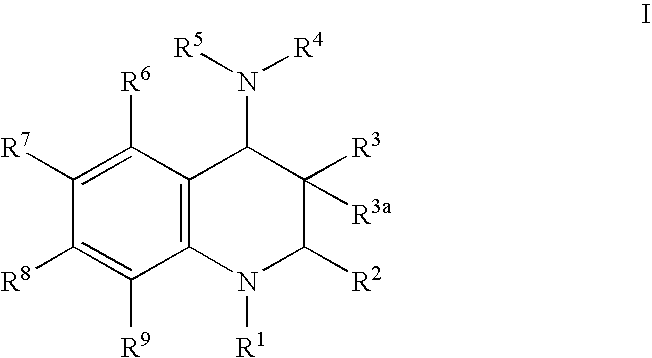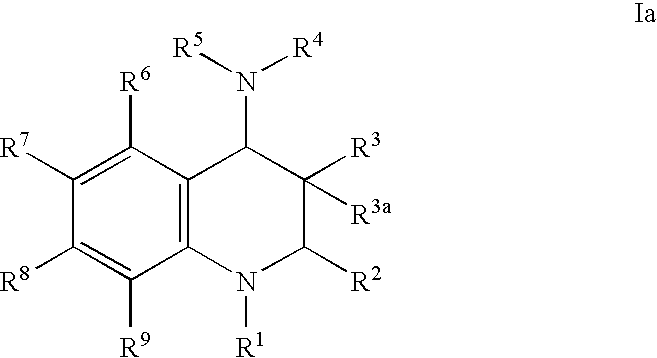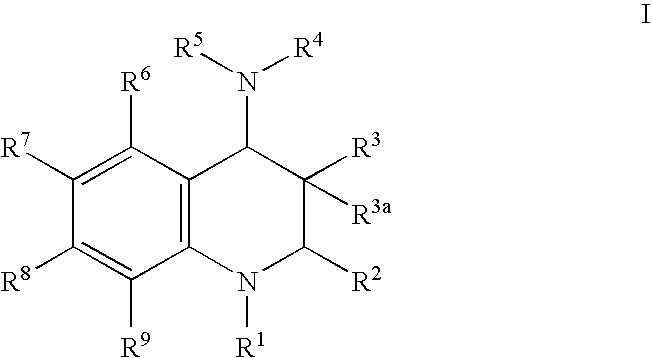Inhibitors of cholesterol ester transfer protein
- Summary
- Abstract
- Description
- Claims
- Application Information
AI Technical Summary
Benefits of technology
Problems solved by technology
Method used
Image
Examples
example 1
[0176]
(1-Benzotriazol-1-yl-propyl)-(4-trifluoromethyl-phenyl)-amine (7)
[0177] A one liter, single neck flask under nitrogen atmosphere was charged with benzotriazole (73.9 g, 621 mmol) and anhydrous toluene (900 mL). A solution of 4-(trifluoromethyl)aniline (100 g, 621 mmol) and toluene (50 mL) was added to the room temperature solution over 5 minutes. A solution of propionaldehyde (39.7 g, 683 mmol) and 50 mL of toluene was then added over 15 minutes. The reaction was stirred for 20 hours and then hexanes (400 mL) was added, and the slurry stirred an additional 20 minutes. The suspension was filtered and the filter cake washed with hexanes (2×100 mL) and then dried under high vacuum to yield compound 7 as a white powder (155 g, 78%).
example 2
[0178]
cis-(2-ethyl-6-trifluoromethyl-1,2,3,4-tetrahydro-quinolin-4-yl)-carbamic acid benzyl ester (8)
[0179] To a solution of N-vinyl-carbamic acid benzyl ester (25.0 g, 141 mmol) in anhydrous toluene (500 mL) was added 7 (45.2 g, 141 mmol) and p-toluenesulfonic acid monohydrate (0.24 g, 1.41 mmol). The reaction was heated to 70° C. for 2 hours and then allowed to cool to room temperature. The reaction mixture was diluted with EtOAc (400 mL) and washed with 1N NaOH (200 mL), water (200 mL), and brine (200 mL). The organic phase was dried over Na2SO4, filtered and concentrated. Toluene (250 mL) was added, followed by 250 mL of hexanes to precipitate compound 8 as a white solid. The solid was filtered and dried under vacuum to provide 36.5 g (68%) of compound 8.
example 3
[0180]
cis-4-Benzyloxycarbonylamino-2-ethyl-6-trifluoromethyl-3,4-dihydro-2H-quinoline-1-carboxylic acid ethyl ester (9)
[0181] A 500 mL, single neck flask was charged with cis-(2-ethyl-6-trifluoromethyl-1,2,3,4-tetrahydro-quinolin-4-yl)-carbamic acid benzyl ester (8) (prepared according to Example 2; 30.0 g, 80.0 mmol), anhydrous dichloromethane (300 mL), and pyridine (9.00 g, 100 mmol). Ethyl chloroformate (10.0 g, 100 mmol) was added slowly over 30 minutes and then NaOH (100 mL, 1N) was added and the reaction stirred for 10 minutes. The separated organic layer was washed with water (100 mL), HCl (100 mL, 1N), sat. NaHCO3 (100 mL), brine (100 mL), then dried over Na2SO4 and filtered. The solids were rinsed with dichloromethane (100 mL). The filtrate was concentrated to dryness resulting in 33.8 g (90%) of compound 9 as a white powder.
PUM
| Property | Measurement | Unit |
|---|---|---|
| Composition | aaaaa | aaaaa |
| Therapeutic | aaaaa | aaaaa |
| Inhibition | aaaaa | aaaaa |
Abstract
Description
Claims
Application Information
 Login to View More
Login to View More - R&D
- Intellectual Property
- Life Sciences
- Materials
- Tech Scout
- Unparalleled Data Quality
- Higher Quality Content
- 60% Fewer Hallucinations
Browse by: Latest US Patents, China's latest patents, Technical Efficacy Thesaurus, Application Domain, Technology Topic, Popular Technical Reports.
© 2025 PatSnap. All rights reserved.Legal|Privacy policy|Modern Slavery Act Transparency Statement|Sitemap|About US| Contact US: help@patsnap.com



